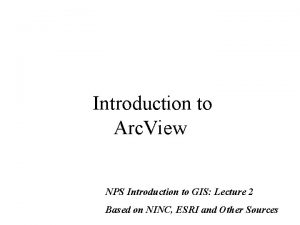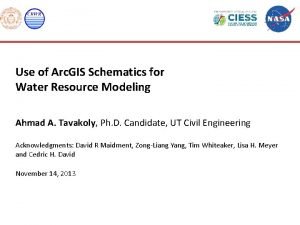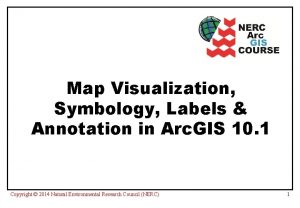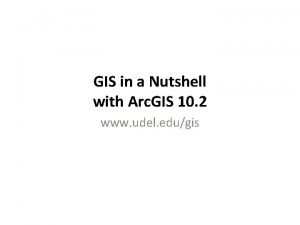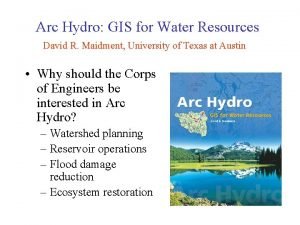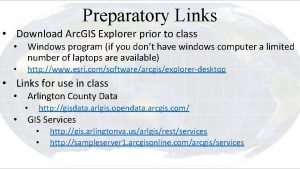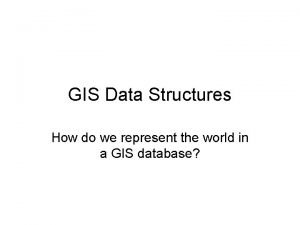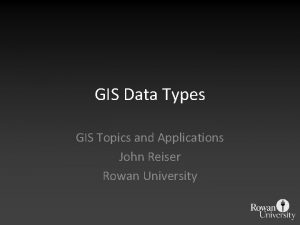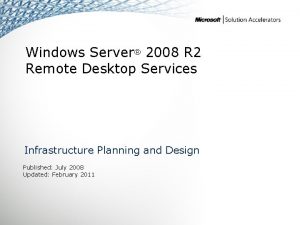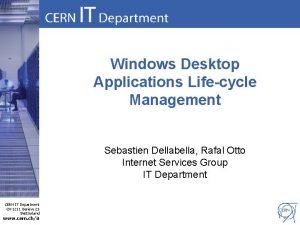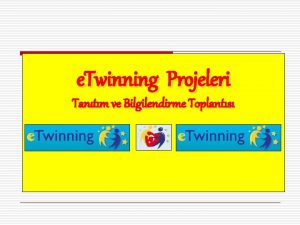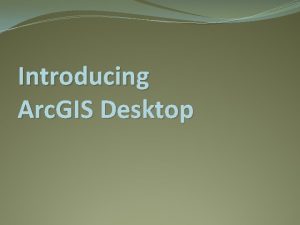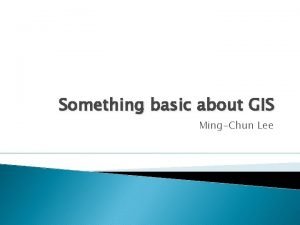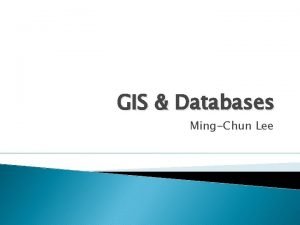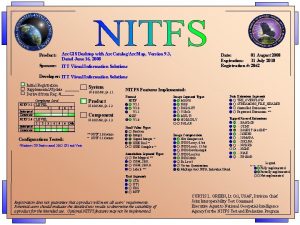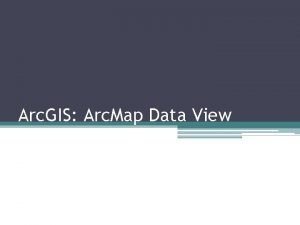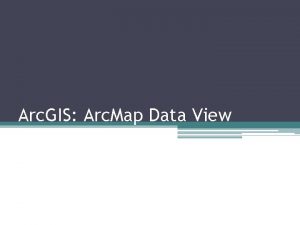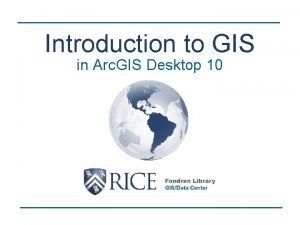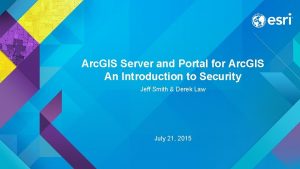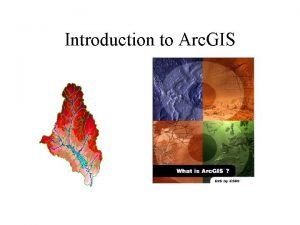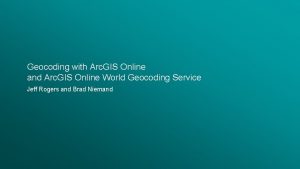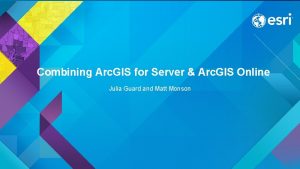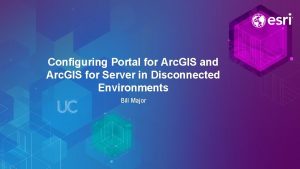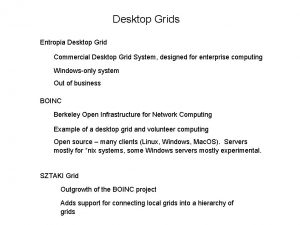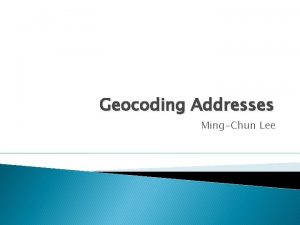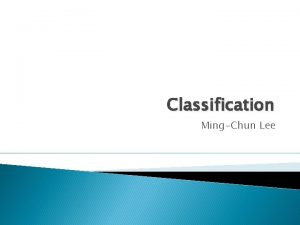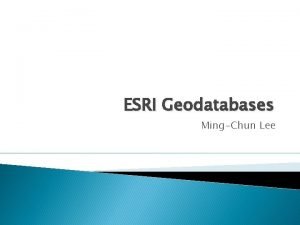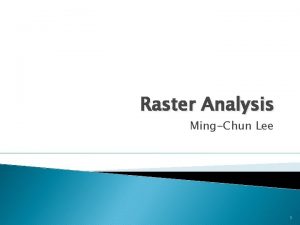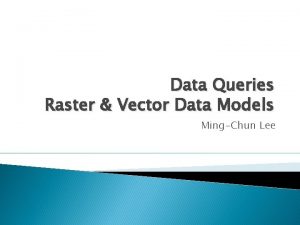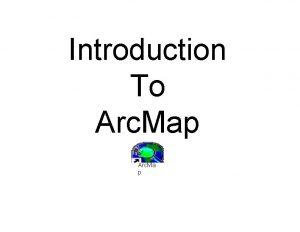Desktop Arc GIS File Types MingChun Lee GIS













































- Slides: 45

Desktop Arc. GIS File Types Ming-Chun Lee

GIS Data Model Concept Administrative Boundaries Utilities Zoning Buildings Parcels Hydrography Streets Digital Orthophoto • Data is organized by layers, or themes. • Layers are integrated using explicit location on the earth’s surface.

Geo-referenced data describes objects from the real world in terms of: ◦ their positions with respect to a coordinate system ◦ their attributes ◦ their spatial interrelations with each other (topology – underlying computational structures for all geo-referenced data in GIS)

Geo-referenced data Geo-reference: xy coordinates + Attribute Data: i. e. Land Use Dwelling Units Land Value Topology: Arc-Node Polygon-Arc Left-Right

Types of Data in GIS Spatial Data Attribute Data Topological Data (for later…)

Spatial Data Structures Vector Representation Raster Representation point line polygon

Spatial Data Structures Vector data model – location referenced by x, y coordinates, which can be linked to form lines and polygons – attributes referenced through unique ID number to tables – Examples • DIME and TIGER files from US Census • DLG from USGS for streams, roads, etc – best for features with discrete boundaries: i. e. soil type, land use Raster data model – location is referenced by a grid cell in a rectangular array (matrix) – attribute is represented as a single value for that cell – Examples • images from remote sensing (LANDSAT, SPOT) • elevation data from USGS – best for continuous features: i. e. elevation, temperature

Spatial Data Structures Raster data are described by a cell grid, one value per cell Vector Raster Point Line Zone of cells Polygon

Types of Spatial Data Points ◦ Point Features ◦ Nodes Lines ◦ Simple Lines ◦ Polylines Polygons

Types of Spatial Data Point Features ◦ No Dimensions ◦ Spatial Attributes: X Y (Z)

Types of Spatial Data Simple Lines Polylines Vertices Nodes

Types of Spatial Data Polylines (cont. ) ◦ 1 Object: ◦ 2 Objects: Vertices Nodes

Types of Spatial Data Lines/Polylines (cont. ) ◦ One Dimension: Length ◦ Spatial Attributes: X, Y Coordinates of Nodes & Vertices Lengths of Segments and Total Length

Types of Spatial Data Polygons ◦ Two Dimensions ◦ Spatial Attributes: X, Y Coordinates of Vertices Area Perimeter

Types of Attribute Data Discrete ◦ Categorical ◦ Ordered Continuous ◦ Interval ◦ Ratio

Types of Attribute Data Categorical ◦ No Ordering of Data Values Examples: ◦ ◦ ◦ Land Use Designation Soil Type Zip Code Tree Species Unique Name

Types of Attribute Data Ordered ◦ Data Values Ordered, but Distances Irrelevant Examples: ◦ Street Functional Classification ◦ Level of Government (City/County/State/Fed) ◦ School Level (Elementary/Middle/High/College)

Types of Attribute Data Interval ◦ Data Values Ordered, and Interval Distances are Relevant, but Base “ 0” Value is Arbitrary or Irrelevant and Ratio Calculations Meaningless Examples: ◦ Elevation from Sea Level ◦ Temperature in °C, °F (but not Kelvin) ◦ Time Relative to 1 AD

Types of Attribute Data Ratio ◦ Data Values Ordered, Interval Distances and Base “ 0” Value are Relevant, and Ratio Calculations Meaningful Examples: ◦ ◦ Length, Area Price $ Temperature in Kelvin Time Relative to Big Bang

Types of questions Where is object A? Where is A in relation to B? How many occurrence of type A are there within distance D of B? What is the value of function Z at position X? How large is B? (Area, Perimeter) What is the result of intersecting layer A and layer B? What is the path of least cost or distance from X to Y along pathway P? What is at points X 1, X 2, …? What objects are next to objects having certain attributes? Reclassify objects having certain combination of attributes. Simulate the effect of process P over time T for a given scenario S.

ESRI GIS Products

ESRI GIS Products

Arc. GIS is a family of software mapping tools The scalability of Arc. GIS provides users with the ability to deploy the software in a variety of ways, from desktop mapping to enterprise GIS.

Arc. GIS The Arc. GIS suite contains § Desktop application (we will be using in this class) § Data server application (Arc. SDE) § Application servers (Arc. GIS Server) § Internet mapping servers (Arc. IMS)

Arc. GIS Desktop is an integrated suite of advanced GIS applications and interfaces, including ◦ ◦ ◦ Arc. Map, Arc. Catalog, Arc. Globe, Arc. Scene, Arc. Toolbox, and Model. Builder.

Arc. GIS Desktop Arc. Info Arc. Editor Arc. View Arc. GIS Desktop is scalable to meet the needs of many types of users. It is available at three functional levels: ◦ Arc. View focuses on comprehensive data use, mapping, and analysis. ◦ Arc. Editor adds advanced geographic editing and data creation. ◦ Arc. Info is a complete, professional GIS desktop product containing comprehensive GIS functionality, including rich geoprocessing capabilities.

Arc. GIS Desktop Additional capabilities can be added to all levels through a series of Arc. GIS Desktop Extensions from ESRI. Users can also develop their own custom extensions to Arc. GIS Desktop by working with Arc. Objects, the Arc. GIS software component library. Also can develop extensions and custom tools using standard Windows programming interfaces, such as Visual Basic, . NET, Java, and Visual C++

ESRI’s Arc. GIS Platform Three Main Applications introduced in this class: ◦ Arc. Catalog ◦ Arc. Map ◦ Arc. Toolbox

Arc. Map is the central application in Arc. GIS for all map-based tasks including cartography, map analysis, and editing.

Arc. Map Arc. Map document files (. mxd) do not “contain” copies of data sets Arc. GIS map documents contain instructions that include pointers to data location File locations are coded into project files Very important to know where the data sets are!

Copying & Moving Map (. mxd) Documents Copying & moving map documents does NOT copy or move data sets Data sets must be either: ◦ Moved Identical file structure ◦ Copied Identical file structure ◦ Specified Restructure your. mxd map document

Map documents may specify absolute or relative path names to data sources

Absolute or Relative path ◦ With relative path names, if data sets are in the same folder as the map document, the entire folder can be moved, copied, or renamed. ◦ With absolute path names, file structures must be recreated identically if map documents and data sets are to be copied to a different computer

General System File Management GIS is more file-intensive than most other computer applications Knowledge of Windows OS file system operation is critical Disk, directory, and file management skills

Setting the Working Directory Set the working directory early Avoids major headache later Always have no doubt about where new files will be placed TIPs: ◦ Create a new directory for each project ◦ Set working directory to this new directory

Arc. Catalog The Arc. Catalog application organizes and manages all GIS information such as maps, globes, data sets, models, metadata, and services.

Metadata – Data about Data Contents of GIS Metadata: ◦ Identification: Title, Area, Dates, Owners, Organization; ◦ Data Quality: Attribute Accuracy, Spatial Precision, Consistency, Data Sources, Production Methods; ◦ Spatial Data Organization: Raster/Vector Model, Structure of Features in the Dataset; ◦ Spatial Georeferencing: Projection, Grid System, Datum, Coordinate system; ◦ Features and Attributes: Database/Attribute Table Definitions, Codes, and Categories; and ◦ Distribution: How to obtain data, contact info for source, list of available formats, fees.

Metadata records are indexed into international library standard (“Z 39. 50 protocol”) databases ◦ Databases are searchable ◦ Content-standardized metadata is the foundation of a robust searching tool ◦ Not through Google ◦ geodata. gov: http: //gos 2. geodata. gov/wps/portal/gos Metadata records have no requirement to provide actual data sets!

Metadata Toolbar Viewing Metadata in Arc. Catalog Click to Edit

Arc. Toolbox is an interface for accessing the data conversion and analysis function that come with Arc. GIS.

Arc. Catalog: File Types 41

Relationships Among Types Table Arc. Map Project (Symbology, Layout) Raster Layer (Symbology) Shapefile (Spatial Data, Attribute Data) Raster Dataset Vector Layer (Symbology) Coverage (Spatial Data, Attribute Data, Topology) 42

Terminology dataset = data layer = theme = feature class (vector data model) ◦ All mean “a piece” of geospatial data Feature dataset however means a collection of feature classes in a ESRI geodatabase data model either Vector or Raster

Geodatabase Geodatabases are the new preferred data storage standard for Arc. GIS ◦ A “container” for data sets feature classes (vector data) raster data tables ◦ Manage with Arc. Catalog

Geodatabase Two formats: ◦ MS Access mdb format (“personal geodatabase”) 2 GB size limit ◦ Special files in a folder (“file geodatabase”) 1 TB size limit
 File-file yang dibuat oleh user pada jenis file di linux
File-file yang dibuat oleh user pada jenis file di linux Arc promoteur vs arc investigateur
Arc promoteur vs arc investigateur Minor arc and major arc
Minor arc and major arc What is a minor arc
What is a minor arc Arc emu88 com arc info 05 100005 html
Arc emu88 com arc info 05 100005 html Arc view gis
Arc view gis Arc gis
Arc gis Arc gis map
Arc gis map Gis
Gis Arc hydro gis for water resources
Arc hydro gis for water resources Arc gis
Arc gis Arc gis explorer
Arc gis explorer Arc gis 10
Arc gis 10 Physical image vs logical image
Physical image vs logical image File sharing management system
File sharing management system Distributed file system
Distributed file system Markup tag tells the web browser
Markup tag tells the web browser In a file-oriented information system, a transaction file
In a file-oriented information system, a transaction file Gis data structure
Gis data structure Gis data types
Gis data types Movie maker file formats
Movie maker file formats Example of serial file organization
Example of serial file organization Remote desktop virtualization host role server 2012
Remote desktop virtualization host role server 2012 Cmf cern
Cmf cern Intel pentium
Intel pentium Nau virtual desktop
Nau virtual desktop Installigel
Installigel Ucl software library
Ucl software library Application desktop delivery
Application desktop delivery Ucl dropbox
Ucl dropbox Desktop @ucl
Desktop @ucl ?rs:embed=true
?rs:embed=true Enterprise desktop virtualization
Enterprise desktop virtualization Microsoft app v
Microsoft app v Microsoft desktop optimization pack download
Microsoft desktop optimization pack download Microsoft desktop optimization pack 2018 download
Microsoft desktop optimization pack 2018 download Mcps desk
Mcps desk Managed desktop services
Managed desktop services Document
Document Ibm virtual desktop infrastructure
Ibm virtual desktop infrastructure Genesys agent desktop
Genesys agent desktop Gartner magic quadrant vdi
Gartner magic quadrant vdi Finesse agent desktop
Finesse agent desktop Etwinning profil örnekleri
Etwinning profil örnekleri Dtp software name
Dtp software name Advantages of using desktop publishing software
Advantages of using desktop publishing software





